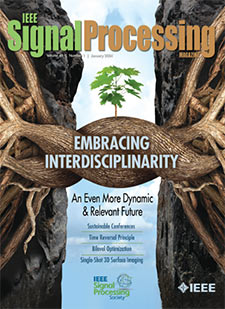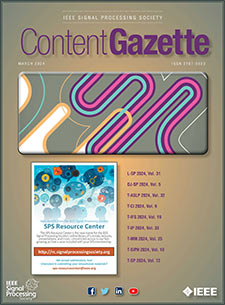- Our Story
- Publications & Resources
- Publications & Resources
- Publications
- IEEE Signal Processing Magazine
- IEEE Journal of Selected Topics in Signal Processing
- IEEE Signal Processing Letters
- IEEE/ACM Transactions on Audio Speech and Language Processing
- IEEE Transactions on Computational Imaging
- IEEE Transactions on Image Processing
- IEEE Transactions on Information Forensics and Security
- IEEE Transactions on Multimedia
- IEEE Transactions on Signal and Information Processing over Networks
- IEEE Transactions on Signal Processing
- IEEE TCI
- IEEE TSIPN
- Data & Challenges
- Submit Manuscript
- Guidelines
- Information for Authors
- Special Issue Deadlines
- Overview Articles
- Top Accessed Articles
- SPS Newsletter
- SigPort
- SPS Resource Center
- Publications Feedback
- Publications FAQ
- Blog
- News
- Dataset Papers
- Conferences & Events
- Community & Involvement
- Professional Development
- For Volunteers
- Information for Authors-OJSP
-
Home
Conferences Events IEEE JSTSP Article IEEE Signal Processing Magazine IEEE TIFS Article IEEE TMM Article IEEE TSP Article Jobs in Signal Processing Lectures Machine Learning Seasonal Schools Signal Processing News SPM Article SPS Distinguished Lectures SPS Newsletter Article SPS Webinar SPS Webinars SPS Webinar Series Webinar webinars
-
Our Story
What is Signal Processing?

The technology we use, and even rely on, in our everyday lives –computers, radios, video, cell phones – is enabled by signal processing. Learn More » -
Publications & Resources
-
SPS Resources
- Signal Processing Magazine The premier publication of the society.
- SPS Newsletter Monthly updates in Signal Processing
- SPS Resource Center Online library of tutorials, lectures, and presentations.
- SigPort Online repository for reports, papers, and more.
- SPS Feed The latest news, events, and more from the world of Signal Processing.
-
SPS Resources
-
Conferences & Events
-
Community & Involvement
-
Membership
- Join SPS The IEEE Signal Processing Magazine, Conference, Discounts, Awards, Collaborations, and more!
- Chapter Locator Find your local chapter and connect with fellow industry professionals, academics and students
- Women in Signal Processing Networking and engagement opportunities for women across signal processing disciplines
- Students Scholarships, conference discounts, travel grants, SP Cup, VIP Cup, 5-MICC
- Young Professionals Career development opportunities, networking
- Get Involved
-
Technical Committees
- Applied Signal Processing Systems
- Audio and Acoustic Signal Processing
- Bio Imaging and Signal Processing
- Computational Imaging
- Image Video and Multidimensional Signal Processing
- Information Forensics and Security
- Machine Learning for Signal Processing
- Multimedia Signal Processing
- Sensor Array and Multichannel
- Signal Processing for Communication and Networking
- Signal Processing Theory and Methods
- Speech and Language Processing
- Technical Working Groups
- More TC Resources
-
Membership
-
Professional Development
-
Professional Development
- Mentoring Experiences for Underrepresented Young Researchers (ME-UYR)
- Micro Mentoring Experience Program (MiME)
- Distinguished Lecturer Program
- Distinguished Lecturers
- Distinguished Lecturer Nominations
- Past Lecturers
- Distinguished Industry Speaker Program
- Distinguished Industry Speakers
- Distinguished Industry Speaker Nominations
- Industry Resources
- IEEE Training Materials
- Jobs in Signal Processing: IEEE Job Site
-
Career Resources
- SPS Education Program Educational content in signal processing and related fields.
- Distinguished Lecturer Program Chapters have access to educators and authors in the fields of Signal Processing
- PROGRESS Initiative Promoting diversity in the field of signal processing.
- Job Opportunities Signal Processing and Technical Committee specific job opportunities
- Job Submission Form Employers may submit opportunities in the area of Signal Processing.
-
Professional Development
-
For Volunteers
-
For Board & Committee Members
- Board Agenda/Minutes* Agendas, minutes and supporting documentation for Board and Committee Members
- SPS Directory* Directory of volunteers, society and division directory for Board and Committee Members.
- Membership Development Reports* Insight into the Society’s month-over-month and year-over-year growths and declines for Board and Committee Members
-
For Board & Committee Members
Popular Pages
Today's:
- Awards & Submit Award Nomination
- Submit a Manuscript
- IEEE/ACM Transactions on Audio Speech and Language Processing
- Information for Authors
- Signal Processing 101
- Conference Call for Papers
- IEEE Transactions on Information Forensics and Security
- IEEE Signal Processing Magazine
- SPS Scholarship Program
- IEEE Transactions on Multimedia
- SPS Travel Grants
- IEEE Transactions on Image Processing
- (ICASSP 2025) 2025 IEEE International Conference on Acoustics, Speech and Signal Processing
- IEEE Journal of Selected Topics in Signal Processing
- Login
All time:
- Information for Authors
- Submit a Manuscript
- IEEE Transactions on Image Processing
- 404 Page
- IEEE/ACM Transactions on Audio Speech and Language Processing
- IEEE Transactions on Information Forensics and Security
- IEEE Transactions on Multimedia
- IEEE Signal Processing Letters
- IEEE Transactions on Signal Processing
- Conferences & Events
- IEEE Journal of Selected Topics in Signal Processing
- Information for Authors-SPL
- Conference Call for Papers
- Signal Processing 101
- IEEE Signal Processing Magazine
Last viewed:
- Action: Host a Technical Meeting for your Chapter
- (CBMI 2024) 2024 International Conference on Content-based Multimedia Indexing (CBMI)
- (IPSN 2024) 2024 International Conference on Information Processing in Sensor Networks
- SPS Student Services Committee Webinar: Effectively Applying for Industrial Research
- SPS Staff
- Awards & Submit Award Nomination
- (ICIP 2024) 2024 IEEE International Conference on Image Processing
- (SLT 2024) 2024 IEEE Spoken Language Technology Workshop
- Zero-Shot Learning via Robust Latent Representation and Manifold Regularization
- Information for Authors
- IEEE/ACM Transactions on Audio Speech and Language Processing
- Spring 2024 Edition of the Speech and Language Processing Technical Committee (SLTC) Newsletter
- IEEE Transactions on Image Processing
- (ACSSC 2024) 2024 Asilomar Conference on Signals, Systems, and Computers
- LIMMITS’23 - Lightweight, Multi-Speaker, Multi-Lingual Indic Text-to-Speech: ICASSP 2023
Yang, Fan. (University of Maryland, College Park), “Leveraging Multiple Features for Image Retrieval and Matching” (2016)
You are here
Newsletter Menu
Newsletter Categories
Top Reasons to Join SPS Today!
1. IEEE Signal Processing Magazine
2. Signal Processing Digital Library*
3. Inside Signal Processing Newsletter
4. SPS Resource Center
5. Career advancement & recognition
6. Discounts on conferences and publications
7. Professional networking
8. Communities for students, young professionals, and women
9. Volunteer opportunities
10. Coming soon! PDH/CEU credits
Click here to learn more.
News and Resources for Members of the IEEE Signal Processing Society
Yang, Fan. (University of Maryland, College Park), “Leveraging Multiple Features for Image Retrieval and Matching” (2016)
Yang, Fan. (University of Maryland, College Park), “Leveraging Multiple Features for Image Retrieval and Matching” (2016) Advisor: Davis, Larry S.
The goal of image retrieval and matching is to find and locate object instances in images from a large-scale image database. While visual features are abundant, how to combine them to improve performance by individual features remains a challenging task. In this work, the authors focus on leveraging multiple features for accurate and efficient image retrieval and matching.
The authors first propose two graph-based approaches to rerank initially retrieved images for generic image retrieval. In the graph, vertices are images while edges are similarities between image pairs. Their first approach employs a mixture Markov model based on a random walk model on multiple graphs to fuse graphs. The authors introduce a probabilistic model to compute the importance of each feature for graph fusion under a naive Bayesian formulation, which requires statistics of similarities from a manually labeled dataset containing irrelevant images. To reduce human labeling, the authors further propose a fully unsupervised reranking algorithm based on a submodular objective function that can be efficiently optimized by greedy algorithm. By maximizing an information gain term over the graph, their submodular function favors a subset of database images that are similar to query images and resemble each other. The function also exploits the rank relationships of images from multiple ranked lists obtained by different features.
The authors then study a more well-defined application, person re-identification, where the database contains labeled images of human bodies captured by multiple cameras. Re-identifications from multiple cameras are regarded as related tasks to exploit shared information. The authors apply a novel multi-task learning algorithm using both low level features and attributes. A low rank attribute embedding is joint learned within the multi-task learning formulation to embed original binary attributes to a continuous attribute space, where incorrect and incomplete attributes are rectified and recovered.
To locate objects in images, the authors design an object detector based on object proposals and deep convolutional neural networks (CNN) in view of the emergence of deep networks. The authors improve a Fast RCNN framework and investigate two new strategies to detect objects accurately and efficiently: scale-dependent pooling (SDP) and cascaded rejection classifiers (CRC). The SDP improves detection accuracy by exploiting appropriate convolutional features depending on the scale of input object proposals. The CRC effectively utilizes convolutional features and greatly eliminates negative proposals in a cascaded manner, while maintaining a high recall for true objects. The two strategies together improve the detection accuracy and reduce the computational cost.
Open Calls
TC News
News & Announcements
Society News
Research Opportunities
Initiatives & Trends
SPS on Twitter
- DEADLINE EXTENDED: The 2023 IEEE International Workshop on Machine Learning for Signal Processing is now accepting… https://t.co/NLH2u19a3y
- ONE MONTH OUT! We are celebrating the inaugural SPS Day on 2 June, honoring the date the Society was established in… https://t.co/V6Z3wKGK1O
- The new SPS Scholarship Program welcomes applications from students interested in pursuing signal processing educat… https://t.co/0aYPMDSWDj
- CALL FOR PAPERS: The IEEE Journal of Selected Topics in Signal Processing is now seeking submissions for a Special… https://t.co/NPCGrSjQbh
- Test your knowledge of signal processing history with our April trivia! Our 75th anniversary celebration continues:… https://t.co/4xal7voFER
Home | Sitemap | Contact | Accessibility | Nondiscrimination Policy | IEEE Ethics Reporting | IEEE Privacy Policy | Terms | Feedback
© Copyright 2024 IEEE – All rights reserved. Use of this website signifies your agreement to the IEEE Terms and Conditions.
A not-for-profit organization, IEEE is the world's largest technical professional organization dedicated to advancing technology for the benefit of humanity.








